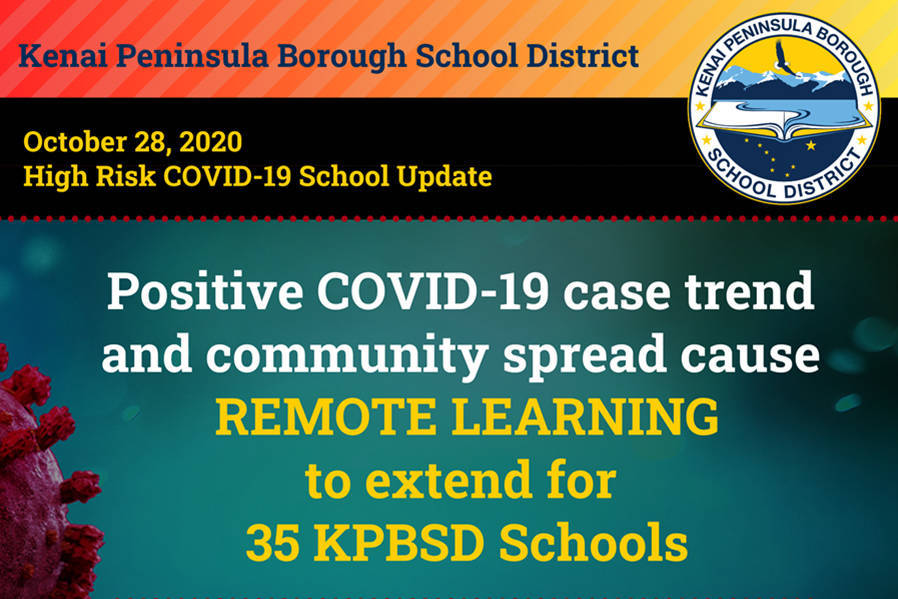The district launched a parent and guardian survey Friday to get community feedback on how to best resume on-site learning for schools operating at high-risk level. A survey was circulated among district staff last week.
The district proposed different options for bringing students back into schools safely in a Nov. 6 announcement. One option includes bringing all students back, except for those who have opted to do remote learning, with increased COVID-19 mitigation protocols in place. Another option is to divide enrolled students into two groups that will have alternating schedules.
For example, the first group may attend in-person classes on Monday and Tuesday, while the second attends Wednesday and Thursday. More sample configurations can be found on communications.blogs.kpbsd.k12.ak.us. According to the district, “An A/B schedule will allow all schools the maximum distancing possible between students and between students and staff.”
During last Monday’s KPBSD School Board meeting, the board heard feedback from parents, teachers and students about their experiences with remote learning. Many said they were struggling with the virtual learning environment while others said it was necessary to prevent further spread of COVID-19.
In a Nov. 4 announcement, KPBSD Superintendent John O’Brien said that new reopening plans will be sent to the Alaska Department of Health and Senior Services for review and then to the school board for approval and adoption.
In determining whether to reopen a school to on-site learning, the district and their Medical Advisory Team analyze 14-day positive case counts and the seven-day positivity trend, consult with medical providers and public health and review their school decision matrix.
Susan B. English School in Seldovia resumed on-site learning Monday. The school first began remote learning on Oct. 27 after the district confirmed a positive COVID-19 case in the community. Cooper Landing School, Hope School, Nanwalek School, Port Graham School and Tebughna School are also currently operating at low-risk levels.
DHSS created risk levels as part of a plan to reopen long-term care facilities to visitors, but DHSS says risk levels also can be used to inform decisions by other entities, including schools, institutions of higher learning and businesses.
During 100% remote learning, Get-It and Go meals are free for all students and can be picked up daily at school. Pre-K, kindergarten and special education intensive needs students can still attend classes in-person during 100% remote learning.
Operational risk levels, case incidence rates and case numbers by community are updated daily on the district’s risk levels dashboard at covid19.kpbsd.org/dashboard.
Central Peninsula — High Risk: The central peninsula, or Kenai, Nikiski, Soldotna, Sterling and “other North,” had 67 resident cases reported by the state Sunday and Monday for a total of 407 cases in the last 14 days.
The central peninsula is high risk when there are 52 or more cases in the last 14 days, medium risk when there are 51 to 26 cases in the last 14 days, and low risk when there are 25 or fewer cases in the last 14 days.
100% remote learning will continue for central peninsula schools through at least Nov. 13. As of Monday, the central peninsula will need to lose 356 cases from its 14-day case count for schools to drop back into medium risk.
Central peninsula schools include Aurora Borealis Charter School, K-Beach Elementary, Kaleidoscope School of Arts and Sciences, Kenai Alternative School, Kenai Central High School, Kenai Middle School, Marathon School, Mountain View Elementary, Nikiski Middle-High School, Nikiski North Star Elementary, Redoubt Elementary, River City Academy, Skyview Middle School, Soldotna Elementary School, Soldotna High School, Soldotna Montessori Charter School, Sterling Elementary and Tustumena Elementary.
Southern Peninsula — High Risk: The southern peninsula, or Homer, Fritz Creek, Anchor Point and “other South,” had 12 resident cases reported by the state Sunday and Monday for a total of 45 cases in the last 14 days.
The southern peninsula is at high risk when there are 20 or more cases in the last 14 days, medium risk when there are 19 to 10 cases in the last 14 days, and low risk when there are nine cases or fewer in the last 14 days.
100% remote learning will continue for southern peninsula schools through at least Nov. 13. As of Monday, the southern peninsula will need to lose 26 cases from its 14-day case count for schools to drop back into medium risk.
Southern peninsula schools include Chapman School, Fireweed Academy, Homer Flex School, Homer High School, Kachemak Selo School, McNeil Canyon Elementary, Nikolaevsk School, Ninilchik School, Paul Banks Elementary, Razdolna School, Voznesenka School and West Homer Elementary.
Eastern Peninsula — High Risk: The eastern peninsula, or Seward, had three resident cases reported by the state Sunday and Monday for a total of 17 cases in the last 14 days.
The eastern peninsula is at high risk when there are eight or more cases in the last 14 days, medium risk when there are four to seven cases in the last 14 days, and low risk when there are three or fewer cases in the last 14 days.
100% remote learning will for eastern peninsula schools will continue through at least Nov. 13. As of Monday, the eastern peninsula will need to lose 10 cases from its 14-day case count for schools to drop back into medium risk.
Eastern peninsula schools include Moose Pass School, Seward Elementary, Seward High School and Seward Middle School.
Reach reporter Ashlyn O’Hara at ashlyn.ohara@peninsulaclarion.com.

